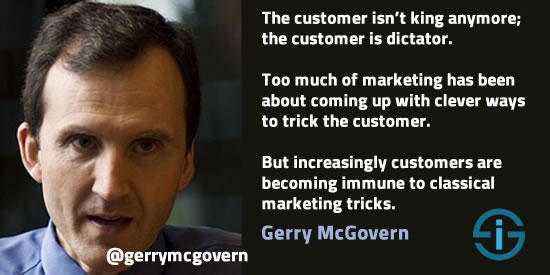Is there such a thing as “digital customer experience” and even a “social customer experience”? Yes and no. We can look at the overall customer experience in the context of digital touchpoints. We can look at individual experiences across digital touchpoints and interactions. Yet, at the same time, it’s important to remember that the customer is not just a digital customer (as in using lots of digital channels and touchpoints).
Separating digital customer experience from customer experience overall, in a world where digital and physical “merge”, would be meaningless if we look at it as a “real” separation.
The customer is one, regardless of channels and devices. Nevertheless, there are many good reasons to take a deeper dive into what has become known as (the) digital customer experience. One of those reasons: the increasing role technology has in the lives of customers and the ways we conduct business in the broadest sense, what digital transformation is largely about as you can read in our deeper dive into the link between digital transformation and customer experience.
The bad news for those who think that “digital” and “big data” is the answer to everything when it boils down to digital customer experience or DCX: forget it.
There is no one-size-fits-all answer and the perception of experiences is as complex and diverse as human emotions are. More bad news: in order to create the conditions for improved customer experiences, culture is at least as important as strategy (remember the famous, be it overused, “culture eats strategy for breakfast” saying by Peter Drucker) and the ability to work through, across and above long-standing corporate silos and personal agendas is crucial.
The good news: there are several ways to connect improved customer experience and business value with digitized processes and digital “tools”. And there is quite some low-hanging fruit, especially if you chose the path of gradual and prioritized optimization and turning insights, data and feedback into action (knowing that a single source of information is never enough) and if you connect digital customer experience with digital operational excellence.
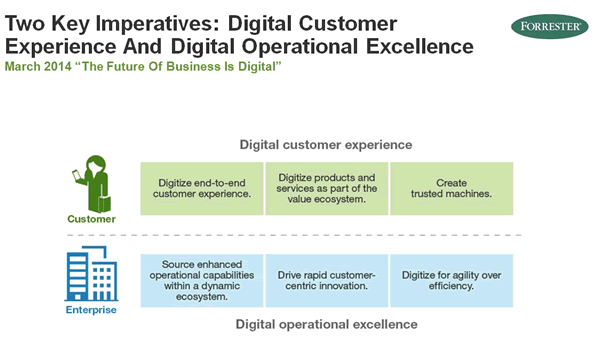
Why digital customer experience?
As people – customers, consumers, prospects – use ever more digital channels and devices in their interactions with brands and organizations, there is an exponential attention for digital customer experience.
It’s well-known that the customer experience in an end-to-end context (as the sum of all experiences across the customer life cycle) is essential for both the future growth and the current bottom-line of any organization. The end-to-end customer experience is essential for customer retention, customer loyalty, word-of-mouth, acquisition and so much more. The exact same thing goes for the digital customer experience.
At the same time we can’t ignore the importance of single customer experiences – also in a digital context. Depending on the customer’s context, intent and expectations a single – poor – customer experience can make or break a business relationship. Nevertheless, and we see it everywhere, the end-to-end customer experience is what matters most in the end.
The growing attention for digital customer experience is related with several evolutions:
- The mentioned rapidly growing use of digital channels, touchpoints and tools/devices by an increasingly “digital customer”.
- The sharply heightened customer expectations that are driven by, among others, the real-time and digital experiences they enjoy in various industries and expect everywhere.
- The increasingly complex and multi-channel behavior of today’s customer who uses multiple channels, often at the same time.
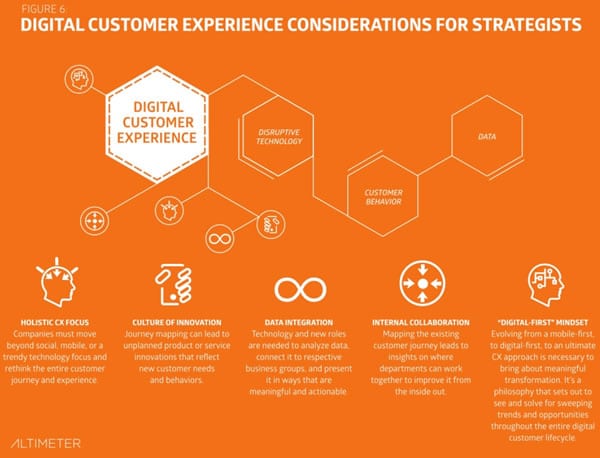
Digital customer experience in the eyes of the customer
The customer doesn’t care about digital customer experience – he cares about experiences and digital.
So, the question remains. Is that attention for the digital customer experience necessary? In the end, the lines between offline and online are blurring. Although digital interactions become so much more important in the overall customer journey and customer experience, is there such a thing as the digital customer experience? And shouldn’t we simply look at the customer experience as such?
For many of us, the notion of an “experience” can seem completely nonsensical; we’re simply trying to pay our bill or change our flight or schedule an engineer as quickly and painlessly as possible. Our customer “experience” — most of the time — is hardly an experience at all.
One thing is for sure: the customers themselves don’t care. As digital gets integrated in “offline” (think about the modern retail store experience), those lines blur from their perspective and they simply want to find what they need fast, their behavior really is channel-agnostic and device-agnostic. Yet, their behavior and usage of the multiple channels and devices matters to us, marketers, customer experience experts, designers, customer service agents, etc.
So, why would we care about the digital customer experience? And what is it if it exists at all?
What sets the digital customer experience apart – if at all?
When we look at the single ‘digital’ customer experience, we see many differences. Look at it this way: there is a total difference between the expectations and experiences we have when seeking customer service via email, the online shopping experience and the perception of online advertising, to mention just a few examples.
To distinguish between each of these interactions and ‘experiences’, there are many parameters to take into account:
- The intent of the customer at any specific moment of interaction.
- The device the customer uses – there’s a huge difference between mobile and desktop, for instance.
- The broader context and task within which the interaction occurs.
- The channels and their specific usage context: email is not Twitter is not an online pricing simulator or a web chat.
- The context within which (digital) brand experiences take place. Think about the perceived intrusiveness and acceptance of various digital advertising formats, that is closely related with the activity people have at any given time in any given platform. Just compare why people go on Facebook versus their mind set when they search in Google.
The picture looks complex. And in all fairness: it is. Marketing and business in the digital age have not become exactly easier.
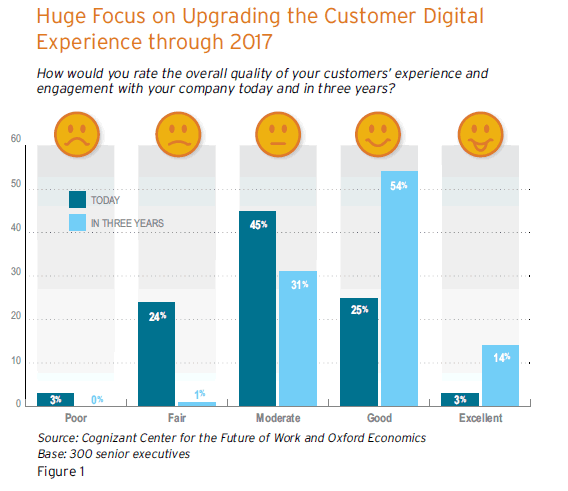
Digital customer experience: where digital, customer and experience meet
So, what’s your organization to do? Trying to close the gaps between the perceptions customers have regarding their experiences when interacting with your business and the perceptions you have about the experiences you “offer”? It is a huge gap, in digital as well.
Or are there other ways to reach that customer experience excellence dream we all want to achieve? Whatever these ways might be, it’s clear they will need to take the individual customer’s context into account as much as possible.
Understanding journeys, intent, channels and behavior – data – is not a matter of gut feeling anymore. It’s imperative to thrive – and maybe even survive. Keeping the complexity we just started to explore in mind, let’s look at the digital customer experience – and how to win the hearts, wallets, kudos and loyalty of the ‘digital’ customer.
Defining the digital customer experience
Just as customer experience or CX is a very broad field that essentially looks at the sum of all experiences and the overall customer lifecycle, digital customer experience overlaps a broad range of activities.
The only way to look at it, remembering that the customer doesn’t care about the difference between digital and non-digital, is seeing the digital customer experience or DCX as an end-to-end given as well. It’s the sum of all customer experiences a customer has with your brand, company, services, offering etc. across all possible digital touchpoints and contact moments.
Dissecting the digital customer experience
Dissecting it, just as is the case with customer experience, is crucial to improve it. The definition of the digital customer experience is one thing, the reality behind it another. And that reality is about to change even more dramatically than it already has in these days of digital pervasiveness. One term in that regard: the Internet of Things.
There are several domains where ‘customer experience’ and ‘digital’ meet:
- The customer experience (expectations) of a digital-savvy customer who uses more digital technologies and channels.
- The customer experience across various digital touchpoints.
- The digital technologies organizations can deploy to enable customer interactions (the front-end) and to improve the customer experience (back-office).
- The experience regarding digital services and products as such. This is one area where the Internet of Things comes into play: smart digital devices that 1) are built by brands and thus influence the perceptions of those brands, 2) come with an entirely different type of experience and 3) offer opportunities to improve customer experiences within the device and/or based on data regarding the usage of the device.
It’s clear that the digital customer experience is about more than what meets the eye today.
The digital customer – it’s all of us
Of particular interest is the ‘digital customer’ as such. Simply defined as the customer who really uses digital channels a lot for all kinds of purposes, this digital customer is changing as well. Just as the customer doesn’t really think about the digital customer experience (he cares about the experiences), he doesn’t care whether he’s a digital customer or not.
However, he sure cares about “digital” channels, tools and of course experiences. The availability of digital channels to interact with brands, seek customer service and so on has even become a key decision factor to do business with an organization. And that – for us – is probably the most essential reason to look at the digital customer experience and at the “digital customer”.
Digital customer experience and digital transformation
Digital transformation and digital customer experience in most cases go hand in hand. However, we shouldn’t make the mistake to reduce digital transformation to just the digital customer experience. Nevertheless, de facto there is a very strong relationship.
More on digital transformation and digital customer experience
- Digital transformation, the customer experience and marketing
- Digital transformation: deep dive into the customer experience
And below is something I added after this article appeared from a later blog post on Forbes with an interesting illustration of the digitization of the customer experience in the context of digital business and digital transformation.
“It’s impossible to have great customer experience without digital transformation in the age of the customer. Most of us think first about the front-end experience when challenged with improving digital customer experience. We naturally gravitate toward the direct human interface: web features and functionality, design, native mobile apps vs mobile web and more. This is the glitz of digital customer experience and there is no relaxing here—your competitors and peers continue to raise the bar”. Ken Calhoon (Forrester) on Forbes.com.
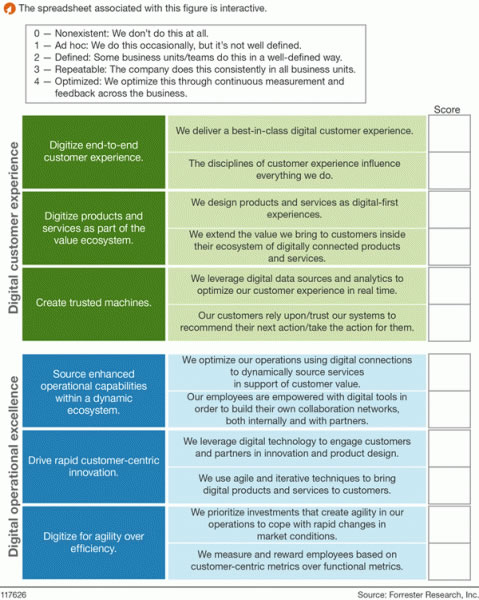
A reminder – remembering the essence
The basics of digital customer experience exist since a log time. Experienced digital marketers with the right customer-centric attitude know them. The best web developers and online usability experts know them. And so do the best digital conversion optimization practitioners (the ubiquitous optimization mindset we need is the logical consequence for anyone interested in genuinely improving the digital customer experience – regardless of generations as some claim but across intent and behavior).
The challenge is 1) not to overlook the essence and 2) understand the contextual dimension of digital experiences, what makes customers tick on and off the Web, the crucial role of digital in today’s customer journey and how data alone doesn’t cut it. Only a holistic perspective works going beyond the limits of channels, devices and tactics but at the same time looking deeper than ever into the atomic particles of the multitude of each digital customer experience.
Let me end with some wisdom from Gerry McGovern
“If you don’t make it fast and easy you lose customers. Fact. The easier you make it the more customers you win. Fact. Businesses are doing an incredibly poor job because to make it easy for the customer you almost always need to make it more complex for the business. Businesses don’t want to take on the complexity of making it easy for customers. We need to develop a return on investment model for ease of use. There are huge returns but we’re not measuring them”. Digital marketing, online usability, CMS and customer experience pioneer Gerry McGovern. Read the interview.


